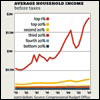The analysis of competitive markets is based on the stated goal of efficiency, or the maximization of social welfare. This ignores potential concerns about equity, the distribution of benefits among the participants in a market economy. In this unit, you will begin to learn about policies that seek to address the balance between efficiency and equity, and what their pros and cons are. These policies include tax and transfer systems, social insurance, and healthcare.

|
Image courtesy of Vince_Lamb on Flickr. |
|
|
Government Redistribution Policy Image courtesy of Ed Marshall on Flickr. |
|
|
U.S. Social Insurance Programs Image courtesy of wisaflcio on Flickr. |
|
|
Image courtesy of University of Nottingham on Flickr. |











